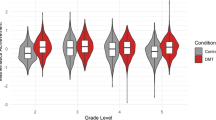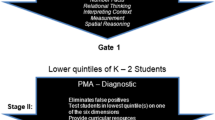Abstract
This article describes a study addressing how Curriculum-Based Measurement mathematics measures function as screening tools for students in grades Kindergarten through 2 over time, and for students in different demographic groups. Specifically, the research questions were: (1) What growth rates are produced for Curriculum-Based Measurement early numeracy measures and are these growth rates significant? (2) Do growth rates for Curriculum-Based Measurement early numeracy measures vary by demographic factors such as gender, race, and lunch status? To answer these questions, predictive validity across multiple years was examined for close to 1000 students in grades Kindergarten through 2 on mathematics measures that included Counting, Number Identification, Missing Number, Quantity Discrimination, Number Facts, Next Number, Computation, and Concepts problems. For all grades, results indicated that some measures increased significantly over time. Differences were observed for students at baseline by gender and lunch status and these covariates also produced differences in growth rates, depending on the measure. Implications for future research and practical implications for early identification and for use by teachers are addressed.
Similar content being viewed by others
References
Chard, D. J., Clarke, B., Baker, S., Otterstedt, J., Braun, D., & Katz, R. (2005). Using measures of number sense to screen for difficulties in mathematics: Preliminary findings. Assessment for Effective Intervention, 30(3), 3–14.
Clarke, B., Baker, S., Smolkowski, K., & Chard, D. J. (2008). An analysis of early numeracy curriculum-based measurement: Examining the role of growth in student outcomes. Remedial and Special Education, 22(1), 46–57.
Clarke, B., Lembke, E., Hampton, D., & Hendricker, E. (2011). Understanding the R in RTI: What we know and what we need to know about measuring student response in mathematics. Brookes Publishing: Baltimore.
Clarke, B., & Shinn, M. R. (2004). A preliminary investigation into the identification and development of early mathematics curriculum-based measurement. School Psychology Review, 33, 234–248.
Conoyer, S. J., Foegen, A., & Lembke, E. S. (2016). Examining predictive validity across years and states using early numeracy indicators. Remedial and Special Education, 37(3), 159–171.
Curran, P. J., Obeidat, K., & Losardo, D. (2010). Twelve frequently asked questions about growth curve modeling. Journal of Cognitive Development, 11(2), 121–136.
Deno, S. L. (1985). Curriculum-based measurement: The emerging alternative. Exceptional Children, 52, 219–232.
Entwisle, D. R., & Alexander, K. L. (1992). Summer setback: Race, poverty, school composition, and mathematics achievement in the first two years of school. American Sociological Review, 57(1), 72–84. Retrieved from http://www.jstor.org/stable/2096145.
Fuchs, L. S. (2003). Assessing intervention responsiveness: Conceptual and technical issues. Learning Disabilities Research and Practice, 18, 172–186.
Fuchs, L. S. (2004). The past, present and future of curriculum based measurement research. School Psychology Review, 33, 188–192.
Fuchs, L. S., & Fuchs, D. (2001). Principles for the prevention and intervention of mathematics difficulties. Learning Disabilities Research and Practice, 10(2), 85–95.
Fuchs, L. S., Fuchs, D., Compton, D. L., Hamlett, C. L., & Seethaler, P. M. (2007). Mathematics screening and progress monitoring at first grade: Implications for responsiveness to intervention. Exceptional Children, 73, 311–330.
Fuchs, L. S., Hamlett, C., & Stecker, P. M. (1991). Effects of curriculum-based measurement and consultation on teacher planning and student achievement in mathematics operations. American Educational Research Journal, 28(3), 617–641.
Gersten, R., & Chard, D. J. (1999). Number sense: Rethinking arithmetic for students with mathematics disabilities. Journal of Special Education, 33(1), 18–28.
Gustavson, K., von Soest, T., Karevold, E., & Roysamb, E. (2012). Attrition and generalizability in longitudinal studies: Findings from a 15-year population-based study and a Monte Carlo simulation study. BMC Public Health, 12, 1–11.
Hampton, D. D., Lemkbe, E. S., Lee, Y. S., Pappas, S., Chiong, C., & Ginsberg, H. (2012). Technical adequacy of early numeracy curriculum-based progress monitoring measures for kindergarten and first grade students. Assessment for Effective Intervention, 37(2), 118–126.
Harwell, M., & LeBeau, B. (2010). Student eligibility for a free lunch as an SES measure in education research. Educational Researcher, 39(2), 120–131.
Harwell, M. R., Maeda, Y., & Lee, K. (2004). Replicating and extending White’s (1982) meta-analysis of the relationship between SES and student achievement. Paper presented at the annual meeting of the American Educational Research Association, San Diego, CA.
Hyde, J. S., Fennema, E., & Lamon, S. J. (1990). Gender differences in mathematics performance: A meta-analysis. Psychological Bulletin, 107(2), 139.
Kaufman, A. S., & Kaufman, N. L. (1985). Kaufman Test of Educational Achievement. Circle Pines, MN: American Guidance Service.
Lembke, E. S., & Foegen, A. (2009). Identifying early numeracy indicators for kindergarten and first grade students. Learning Disabilities Research and Practice., 24, 12–20.
Lembke, E. S., Foegen, A., Whittaker, T. A., & Hampton, D. D. (2008). Establishing technical adequate measures of progress in early numeracy. Assessment for Effective Intervention, 33, 206–214.
Lembke, E. S., Hampton, D. D., & Beyers, S. J. (2012). Response to intervention mathematics: Critical elements. Psychology in the Schools, 49(3), 257–272.
Lubienski, S., & Lubienski, C. (2006). School sector and academic achievement at a multi-level analysis of NAEP mathematics data. American Educational Research Journal, 43(4), 651–698.
Methe, S. A., Hintze, J. M., & Floyd, R. G. (2008). Validation and decision accuracy of earlynumeracy skill indicators. School Psychology Review, 37(3), 359–373.
Okamato, Y., & Case, R. (1996). Exploring the microstructure of children’s central conceptual Structures in the domain of number. Monographs for the Society of Research in Child Development, 61, 27–59.
Rabe-Hesketh, S., & Skrondal, A. (2008). Multilevel and longitudinal modeling using Stata. College Station, TX: Stata.
Raudenbush, S. W., & Bryk, A. S. (2002). Hierarchical linear models: Applications and data analysis methods. Thousand Oaks, CA: Sage.
Shinn, M. R. (1989). Identifying and defining academic problems: Curriculum-based measurement screening and eligibility procedures, (184–203). In M. R. Shinn (Ed.), Curriculum-based measurement: Assessing special children. New York: Guilford.
Singer, J. D., & Willett, J. B. (2003). Applied longitudinal data analysis: Modeling change and event occurrence. New York: Oxford University Press.
Sirin, S. R. (2005). Socioeconomic status and academic achievement: a meta-analytic review of research. Review of Educational Research, 75, 417–453.
Skrongdal, A., & Rabe-Hesketh, S. (2004). Generalized latent variable modeling: Multilevel, longitudinal, and structural equation models. Boca Raton, FL: Chapman and Hall/CRC.
The Psychological Corporation (1992). Weschler Individual Achievement Test. San Antonio, TX.
Woodcock, R. W., McGrew, K. S., & Mather, N. (2001). Woodcock-Johnson® III Test. Riverside Publishing Company. Itasca, IL.
Author information
Authors and Affiliations
Corresponding author
Rights and permissions
About this article
Cite this article
Lembke, E., Lee, Y.S., Park, Y.S. et al. Longitudinal growth on curriculum-based measurements mathematics measures for early elementary students. ZDM Mathematics Education 48, 1049–1063 (2016). https://doi.org/10.1007/s11858-016-0804-x
Accepted:
Published:
Issue Date:
DOI: https://doi.org/10.1007/s11858-016-0804-x




